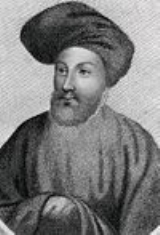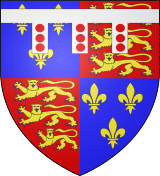
Edward of Norwich, 2nd Duke of York
Encyclopedia
Sir Edward of Norwich, 2nd Duke of York, 2nd Earl of Cambridge, Earl of Rutland, Earl of Cork, Duke of Aumale KG
(1373 – 25 October 1415) was a member of the English royal family
who died at the Battle of Agincourt
.
The son of Edmund of Langley, 1st Duke of York
, and his first wife Isabella of Castile
. He was grandson of two kings, Edward III of England
and Pedro of Castile
.
Edward is thought to have been born in Norwich
. He was close to his cousin King Richard II
, and was created Earl of Rutland (for the term of his father's life) by him in 1390, Earl of Cork
(Ireland) in about 1394, and then Duke of Aumale in 1397. This association put him out of favour after the accession of King Henry IV
, and he was deprived of his Dukedom. In 1400 he participated in a conspiracy
against Henry IV, but betrayed the conspirators to the king. In 1402 he succeeded his father as Duke of York
; the Earldom of Rutland, by its charter, then became extinct, although he continued to sign himself as Earl of Rutland. He married a widow, Philippa de Mohun
, but there were no children from their marriage.
Edward wrote “The Master of Game
”, a translation of the most famous of the hunting treatises of the Middle Ages, the “Livre de Chasse” of Gaston Phoebus, Count de Foix
, adding five chapters of his own.
Edward took part in King Henry V
's war on France and died at the Battle of Agincourt
, the major English casualty in that battle. Although his death is depicted by Shakespeare and his adapters as an act of heroism, it was in fact more of an accident: like many of the French knights, he was unable to remain upright when unhorsed in the fray and effectively died of suffocation under a pile of other men and horses.
On his death, the dukedom did not immediately pass to his nephew, Richard Plantagenet
, as Richard's father Richard of Conisburgh, 3rd Earl of Cambridge
, had been attainted for treason, but the younger Richard was eventually restored to the Dukedom.
As the Duke of Aumerle, he is a major character in William Shakespeare
's Richard II
, and he is also a minor character in Henry V
.

Order of the Garter
The Most Noble Order of the Garter, founded in 1348, is the highest order of chivalry, or knighthood, existing in England. The order is dedicated to the image and arms of St...
(1373 – 25 October 1415) was a member of the English royal family
Monarchy of the United Kingdom
The monarchy of the United Kingdom is the constitutional monarchy of the United Kingdom and its overseas territories. The present monarch, Queen Elizabeth II, has reigned since 6 February 1952. She and her immediate family undertake various official, ceremonial and representational duties...
who died at the Battle of Agincourt
Battle of Agincourt
The Battle of Agincourt was a major English victory against a numerically superior French army in the Hundred Years' War. The battle occurred on Friday, 25 October 1415 , near modern-day Azincourt, in northern France...
.
The son of Edmund of Langley, 1st Duke of York
Edmund of Langley, 1st Duke of York
Edmund of Langley, 1st Duke of York, 1st Earl of Cambridge, KG was a younger son of King Edward III of England and Philippa of Hainault, the fourth of the five sons who lived to adulthood, of this Royal couple. Like so many medieval princes, Edmund gained his identifying nickname from his...
, and his first wife Isabella of Castile
Isabella of Castile, Duchess of York
Infanta Isabella of Castile, Duchess of York was a daughter ofKing Peter of Castile and María de Padilla. She was a younger sister of Constance, Duchess of Lancaster....
. He was grandson of two kings, Edward III of England
Edward III of England
Edward III was King of England from 1327 until his death and is noted for his military success. Restoring royal authority after the disastrous reign of his father, Edward II, Edward III went on to transform the Kingdom of England into one of the most formidable military powers in Europe...
and Pedro of Castile
Pedro of Castile
Peter , sometimes called "the Cruel" or "the Lawful" , was the king of Castile and León from 1350 to 1369. He was the son of Alfonso XI of Castile and Maria of Portugal, daughter of Afonso IV of Portugal...
.
Edward is thought to have been born in Norwich
Norwich
Norwich is a city in England. It is the regional administrative centre and county town of Norfolk. During the 11th century, Norwich was the largest city in England after London, and one of the most important places in the kingdom...
. He was close to his cousin King Richard II
Richard II of England
Richard II was King of England, a member of the House of Plantagenet and the last of its main-line kings. He ruled from 1377 until he was deposed in 1399. Richard was a son of Edward, the Black Prince, and was born during the reign of his grandfather, Edward III...
, and was created Earl of Rutland (for the term of his father's life) by him in 1390, Earl of Cork
Earl of Cork
Earl of the County of Cork, usually shortened to Earl of Cork, is a title in the Peerage of Ireland. It was created in 1620 for the Anglo-Irish politician Richard Boyle, 1st Baron Boyle...
(Ireland) in about 1394, and then Duke of Aumale in 1397. This association put him out of favour after the accession of King Henry IV
Henry IV of England
Henry IV was King of England and Lord of Ireland . He was the ninth King of England of the House of Plantagenet and also asserted his grandfather's claim to the title King of France. He was born at Bolingbroke Castle in Lincolnshire, hence his other name, Henry Bolingbroke...
, and he was deprived of his Dukedom. In 1400 he participated in a conspiracy
Epiphany Rising
The Epiphany Rising was a failed rebellion against Henry IV of England in January 1400.-Background:After the murder of Thomas of Woodstock, 1st Duke of Gloucester in 1397, Richard II rewarded those who had supported him against Gloucester and the Lords Appellant with a plethora of new titles.Upon...
against Henry IV, but betrayed the conspirators to the king. In 1402 he succeeded his father as Duke of York
Duke of York
The Duke of York is a title of nobility in the British peerage. Since the 15th century, it has, when granted, usually been given to the second son of the British monarch. The title has been created a remarkable eleven times, eight as "Duke of York" and three as the double-barreled "Duke of York and...
; the Earldom of Rutland, by its charter, then became extinct, although he continued to sign himself as Earl of Rutland. He married a widow, Philippa de Mohun
Philippa de Mohun
Philippa de Mohun was the wife of Edward of Norwich, 2nd Duke of York, making her the Duchess of York from her husband's accession to the dukedom in 1402 to his death in 1415. Philippa's birthdate is unknown, though it is believed to have been prior to 1376...
, but there were no children from their marriage.
Edward wrote “The Master of Game
The Master of Game
The Master of Game is a medieval book on hunting written by Edward of Norwich, 2nd Duke of York, between 1406 and 1413, of which 27 manuscripts survive. It is considered to be the oldest English-language book on hunting...
”, a translation of the most famous of the hunting treatises of the Middle Ages, the “Livre de Chasse” of Gaston Phoebus, Count de Foix
Gaston III of Foix-Béarn
Gaston III/X of Foix-Béarn, also Gaston Fébus or Gaston Phoebus was the 11th count of Foix, and viscount of Béarn . Officially, he was Gaston III of Foix and Gaston X of Béarn.-Early life:...
, adding five chapters of his own.
Edward took part in King Henry V
Henry V of England
Henry V was King of England from 1413 until his death at the age of 35 in 1422. He was the second monarch belonging to the House of Lancaster....
's war on France and died at the Battle of Agincourt
Battle of Agincourt
The Battle of Agincourt was a major English victory against a numerically superior French army in the Hundred Years' War. The battle occurred on Friday, 25 October 1415 , near modern-day Azincourt, in northern France...
, the major English casualty in that battle. Although his death is depicted by Shakespeare and his adapters as an act of heroism, it was in fact more of an accident: like many of the French knights, he was unable to remain upright when unhorsed in the fray and effectively died of suffocation under a pile of other men and horses.
On his death, the dukedom did not immediately pass to his nephew, Richard Plantagenet
Richard Plantagenet, 3rd Duke of York
Richard Plantagenêt, 3rd Duke of York, 6th Earl of March, 4th Earl of Cambridge, and 7th Earl of Ulster, conventionally called Richard of York was a leading English magnate, great-grandson of King Edward III...
, as Richard's father Richard of Conisburgh, 3rd Earl of Cambridge
Richard of Conisburgh, 3rd Earl of Cambridge
Richard of Conisburgh, 3rd Earl of Cambridge was the younger son of Edmund of Langley, 1st Duke of York and Isabella of Castile....
, had been attainted for treason, but the younger Richard was eventually restored to the Dukedom.
As the Duke of Aumerle, he is a major character in William Shakespeare
William Shakespeare
William Shakespeare was an English poet and playwright, widely regarded as the greatest writer in the English language and the world's pre-eminent dramatist. He is often called England's national poet and the "Bard of Avon"...
's Richard II
Richard II (play)
King Richard the Second is a history play by William Shakespeare believed to be written in approximately 1595. It is based on the life of King Richard II of England and is the first part of a tetralogy, referred to by some scholars as the Henriad, followed by three plays concerning Richard's...
, and he is also a minor character in Henry V
Henry V (play)
Henry V is a history play by William Shakespeare, believed to be written in approximately 1599. Its full titles are The Cronicle History of Henry the Fifth and The Life of Henry the Fifth...
.


